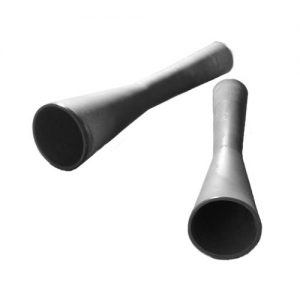Syalon 101 and Syalon 050 are characterised by excellent mechanical strength and hardness, making them ideal candidates for many extreme industrial wear applications.
Milling Media
International Syalons manufacture a range of grinding media for the preparation of industrial and analytical samples.
In trials, weight losses for Syalon 101 bowls and media were about 14% of the reported weight losses for agate, alumina, zirconia and tungsten carbide, thus vastly reducing contamination of the sample as well as extending the media life.
In addition, milling efficiencies for Syalon 101 are also generally improved, meaning milling times are reduced.
Shot Blast Nozzles
Shot blasting is a method of surface preparation or cleaning. It involves blasting an abrasive grit, such as sand, alumina or chill cast iron, at high velocities at the surface to be treated.
Traditionally liners have been made from tungsten carbide. However, at the low angle impacts encountered in many blasting operations, tungsten carbide nozzles wear excessively due to the erosion of the relatively soft and ductile cobalt used to cement the carbide grains together.
Syalon 050 has a high hardness, fracture toughness and Young’s modulus, resulting in excellent wear resistant properties, making it an ideal material for shot blast liners.
A standard 3/8″ nozzle in Syalon 050 tested using chill–cast iron grit and operating at 100psi, performed for more than 1000 hours without appreciable wear.
Paper Dewatering Foils
During the manufacture of paper a section of the process involves removing water from the fibre/water pulp. To do this, the pulp is spread over a fabric mat which travels over a series of suction boxes. These boxes apply a vacuum which draws the water out of the pulp as the fabric travels over them.
The suction boxes consist of a series of foils, which can be many metres long. The foils can be made of high-density polyethylene (HDPE) or ceramic material. Ceramics are used in high-speed applications. The foils are diamond ground to give a mirror finish, which is important for the quality of finish of the paper.
Initially, alumina was the ceramic of choice. However, as machine speeds have increased, up to 100km/min, so the requirement for greater wear resistance has emerged. This is where Syalon 101 comes in. Its excellent wear resistant properties, as well as thermal shock resistance, make it the ideal choice for modern high-speed applications.

